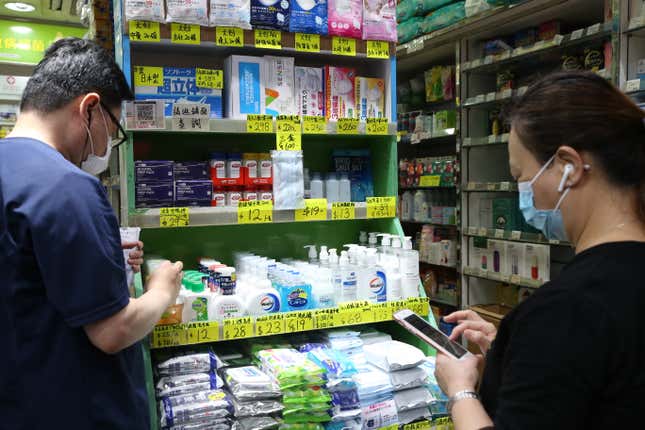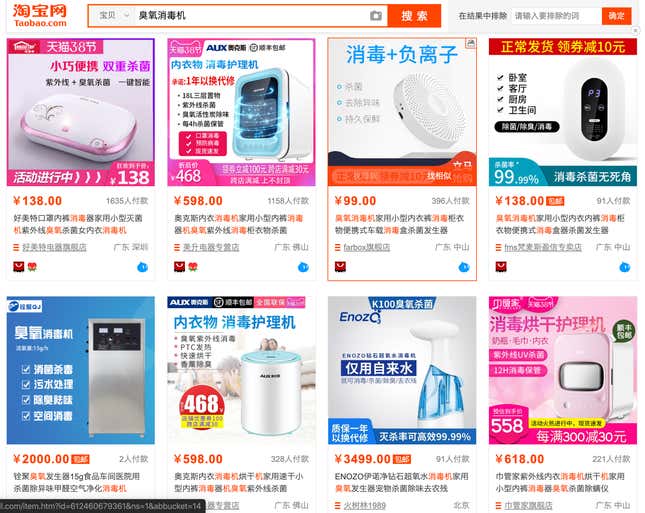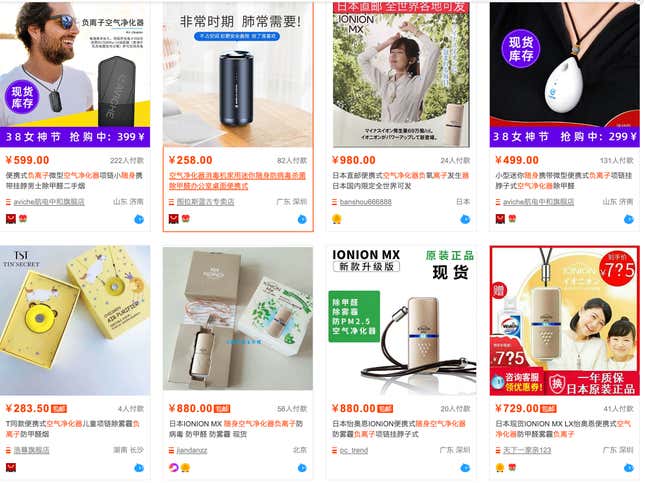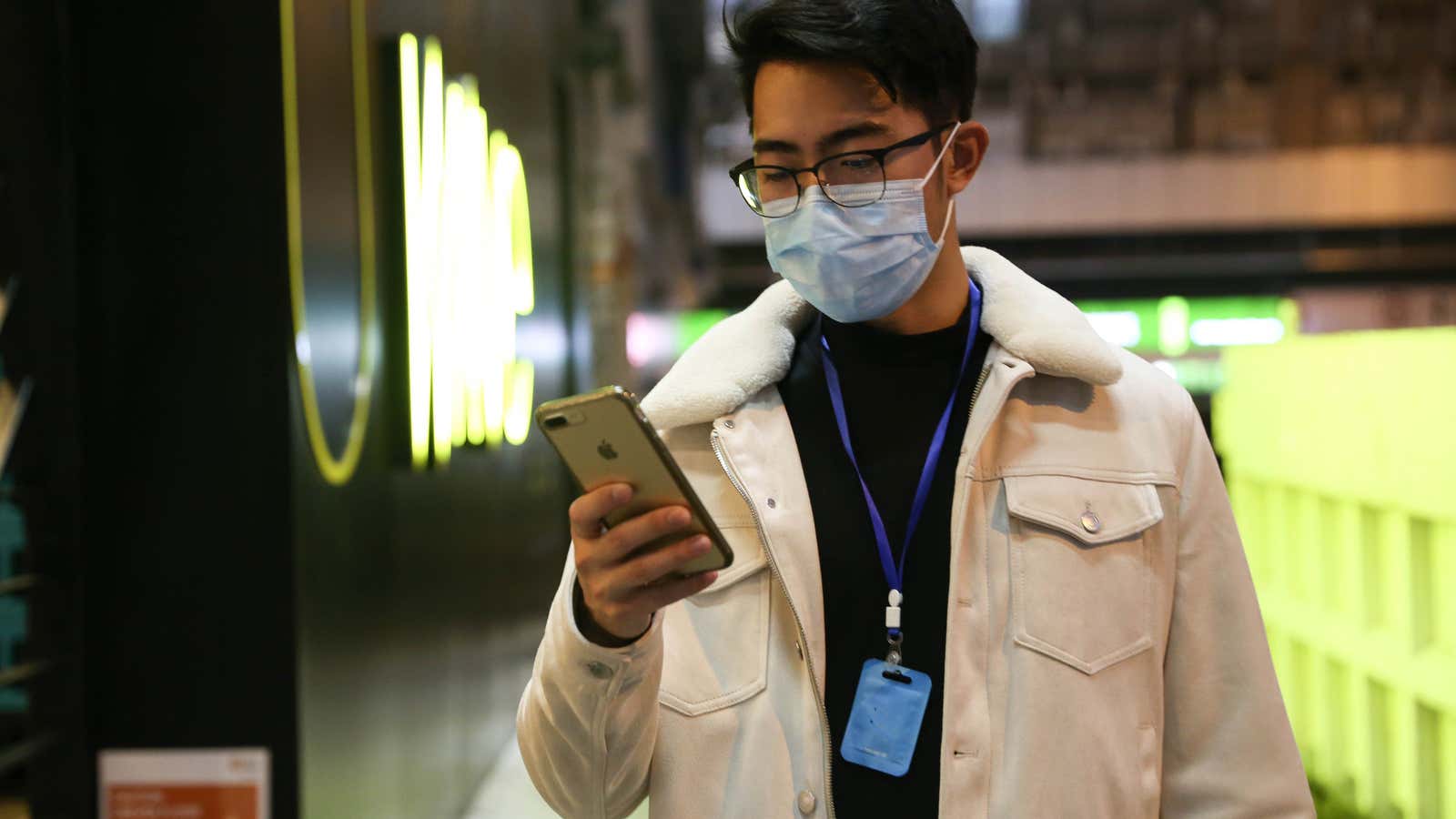There’s more than just hand sanitizer and soap when it comes to disinfecting during an epidemic.
Since the outbreak of the coronavirus in January, a plethora of products that claim to be able to kill germs have proliferated, mostly in Asian countries—perhaps a sign of those societies’ collective memories of past epidemics such as SARS and avian flu. These inventive products come on top of people already taking most precautions, such as wearing face masks, carrying bottles of alcohol gel everywhere, and religiously cleaning their environs with bleach.
Yet many of these alternative products do not live up to their marketing claims and some may even do more harm than good. Here’s what one Hong Kong-based scientist had to say about some of them.
Hypochlorous acid
A gentler alternative to bleach, HOCl is touted by sellers as a natural, harmless disinfectant and sold as sprays under different names such as Nano Guard (link in Chinese) and Water God. They are commonly found in pharmacies, supermarkets, and even vending machines in Hong Kong and Taiwan.
It’s essentially made from the same substances as bleach—sodium hypochlorite. But at a pH of around 6, it is safer to handle than bleach, which is strongly alkaline. It has also been proven to be more effective against bacteria even at a lower concentration.

They can be found in markets in Hong Kong at about HK$100 ($13) a bottle, but Jason Chan, an assistant professor in science education at the Hong Kong University of Science and Technology, said that those vendors are likely selling “99.9% water added with a few drops of pH-adjusted bleach, and these raw materials probably cost less than a dollar.”
Portable air purifier
With names such as Air Doctor or Virus Shut Out, these portable air purifiers, which claim to disinfect the air as the user moves around, are now sold across pharmacies in Hong Kong, and Japan, where they’re made. One packet, which costs around HK$50 and is worn around the neck, can be used for up to 30 days.
Each packet contains sodium chlorite and an acid, both in the form of a solid pellet. When exposed to moisture in the air, they slowly react to give out chlorine dioxide gas, a strong oxidizing agent that can kill pathogenic microorganisms.
However, the protection it can offer is very limited since gas dissipates very quickly, explained Chan, especially outdoors where the air is moving. “The rate of formation will never catch up with the rate of dilution. If someone is sneezing at you, will it be able to kill all the virus particles in the droplets in a fraction of the second? I strongly doubt it.”
Ozone generator
Though advertised as air cleaners on popular Chinese e-commerce platforms such as Taobao, ozone generators are banned in California—and for good reason. “It is one of the products where the risks heavily outweigh the benefits,” said Chan, who strongly advises against using ozone generators in homes and work spaces.

The generators come in sizes as small as a phone to as large as a microwave, with prices ranging from about HK$99 to over HK$2,000.
While it removes smells by reacting with volatile organic compounds, ozone is itself an air pollutant. Poisonous and carcinogenic, it can cause damage to cells and reaches dangerous levels when allowed to accumulate in the air.
Negative ion air purifier
Negative ion air purifiers have been around for years, but light, portable ones that can be carried on-the-go have become popular since the coronavirus outbreak. For example, launched in Hong Kong last year, Mobework is a slick device that can be worn around the neck or clipped on clothes and boasts a 15-hour battery life, while Taiwan brand InfoThink offers them in the form of necklaces, featuring characters from Disney and The Avengers.

Negative ion air purifiers work by electrifying molecules in the air. The negatively charged molecules then bind themselves to other gas particles in the air—be they viruses, dust, or bacteria—which become attracted to surrounding surfaces such as walls and furniture. By increasing the rate of precipitation and reducing the number of such particles floating in the air, the purifier lowers the risk of contamination in an enclosed space.
However, similar to chlorine dioxide gas emitters, its effectiveness drops dramatically outdoors where the air is dynamic. And the process of running air through an electrified plate generates ozone as a side product, so it is not advisable to have it on all the time, said Chan.
UV light sanitizer
Another relatively new product gaining popularity in both Asia and the US is the UV light sanitizer, used for disinfecting accessories such as glasses and smartphones—on which viruses can live for as long as 96 hours.
Created by a company based in the US, PhoneSoap, which simultaneously sanitizes and charges the phone, is already sold out on Amazon. Other options on the market resemble a wand, while others come as containers that disinfect items placed within them.
One reminder from Chan is to read the instructions carefully. Though some boast of killing 99.9% of germs in mere seconds, these statements are mostly exaggerated. While these sanitizers generate beams of ultraviolet light that can break down cellular structures, the process is far slower compared to chemical methods.
“Sterilization is more complete the longer the radiation. It takes time—a few minutes or up to 30 depending on the UV source and the level of contamination,” said Chan, who notes that UV light should not be used on the body as it damages body cells as much as bacteria and is a well-known cause of skin cancer.
